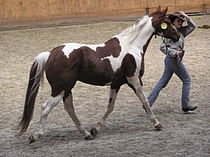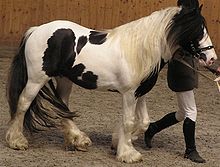Piebald horse
A piebald or piebald (male also a check ) is a horse whose body hair, in addition to a basic color, has clearly delimited white areas that go beyond the extent of normal markings .
While piebalds are undesirable for most horse breeds in our time and are not permitted for breeding , piebalds used to be popular horses because of their specialty. An indication of this is the famous picture of Napoleon on the St. Bernard Pass , of which several versions exist: once Napoleon is sitting on a white horse, once on a piebald.
In tiger piebalds, the same gene creates a number of different check patterns, with small round dark spots on a white background or small round white spots on a dark background.
The rest of the checks are grouped together as plate checks , which are divided into Tobiano and Overo. There are three known types of Overos: The Frame Overo , the Splashed White Overo and the Sabino Overo , whereby the Sabino drawing is caused by several different genes.
Creation of checks
Check drawings usually go back to leucism , as is the horse's various plate check patterns . This means that too few melanoblasts migrate from the neural crest during embryonic development or this migration occurs too late. The cells ( melanocytes ), which are also responsible for the color of the coat , later develop from the melanoblasts .

The brown spots are the melanin produced by the melanocytes. The blue color is caused by a c-Kit antibody and shows where KIT is expressed. This is why the dominant white horse shows far less blue than the colored animal. The same picture would appear on the white skin areas of all piebalds caused by kit mutations.
A skin area can be affected by leucism in different ways. If there are no melanocytes there at all, the skin is pink and hairs that grow there are white. If there are too few melanocytes in a skin area, a random pattern of white and colored hair is created. So the horse has white burin hair there . On the skin areas that have been reached in sufficient numbers by the melanocytes, the fur has the same color as it would have if there were no check gene.
Depending on the check gene, different fur areas are predestined for white spots. However, since spotting is not a carefully controlled process, but a disturbance, the location and extent of the stains are to a considerable extent random.
Each check pattern is possible on each color, so there's Piebald , Fuchs Then , Brown Then and Falbschecken . There are also porcelain checks, which are molds with a check mark. As newborn foals they are piebald and while their fur turns white as life goes on, the skin stays black and pink piebald. This piebald shimmers through the white fur, creating the porcelain-like impression. When the color Smoky cream or Cremello is combined with spotting, the spotting is almost invisible.
 |
 |
 |

|
| Porcelain check (Tobiano fly mold) | Fuchsschecke, Tobiano | Adult horse: mouse fallow; Foal mousefold combined with tiger spotting | Smoky cream combined with spotting, Tobiano |
 |
 |

|
| Fuchsschecke with flaxen, Tobiano | Black checker, Tobiano | Brown check, Tobiano |
In contrast to the plate check of the horse, the tiger check, as it occurs for example in the Appaloosa, is not caused by leucism, but is triggered by a mutation of an ion channel.
Variations in the expression of the spotting
All check patterns have in common that they differ significantly in their characteristics from animal to animal and can often range from the minimal piebald, which looks like a horse without a check mark with clear markings, to the completely white horse.
Minimal piebald
Minimal piebald horses are horses that carry one of the genes that are responsible for the typical piebald markings, but are not piebald.
With some check genes, such as the Sabino and the Splashed white Overo, animals that only carry the gene once, i.e. are heterozygous, are almost never really piebald.
In the case of the most common spotting, the Tobiano check, it does not matter whether an animal is homozygous or heterozygous - in both cases minimal to maximal checks are possible.
Monochrome tiger piebalds are usually heterozygous for the gene.
Clear expression of the check color
 |
 |
 |

|
| Sabino | Tobiano | Splashed white | Tiger piebald: saddle pad |
The tiger check pattern is usually less pronounced in heterozygous animals than in homozygous animals.
Piebald with a lot of white
 |
 |
 |
 |

|
| Tigerschecke: Volltiger | Frame overo | Tobiano | Superimposition of several checks | Probably Tobiano and Splashed white |
Maximum piebald
Maximum piebald horses are horses that are completely white due to piebald genes. A heterozygous horse may happen to be completely covered by a white patch. Homozygous animals are more often completely white, for example, homozygous tiger piebalds are often completely white, but mostly healthy. On the other hand, the homozygous Frame-Overo drawing has achieved sad fame : Foals that have this gene twice are completely white and die within the first few days of life due to colic.
Completely white animals are more common among horses with several different check genes than among horses with only one of these genes.
Overlay of several check patterns, badges can also be inherited independently
When several check patterns overlap, the resulting check is often difficult to classify. Horses with a Tobiano gene and a Frame Overo gene often show a typical Tobiano check.
Since there are some genes for white markings on the face and on the legs, which on their own cannot lead to spotting either in homo- or in heterozygous form, one cannot always infer spotting genes from white markings.
The cKit locus contains the gene for Tobianoscheckung, that for Sabinoscheckung, that for dominant white color and for stylus hairiness. Since horses have a double set of chromosomes, of these four genes they can have at most two different genes or one of these four genes is homozygous.
In contrast, the Frame-Overo- spotting ( EDRNB ) and the tiger spotting (all known leucism loci excluded) each lie on a different gene location and can be combined with the above four genes as desired.
Pintaloosa: tiger check combined with Tobiano check
When a horse has both the Tobiano and Tiger Check genes, a horse known as a pintaloosa results . A pintaloosa usually has strong white markings on its legs and spots that run from top to bottom, that is, vertical rather than horizontal. Both are typical Tobiano characteristics. The tiger peg legacy is sometimes difficult to recognize and is only noticeable by the fact that the white is visible in the normally open eye. When it becomes more apparent, all the drawing features of the tiger piebald complex can appear. The horse can therefore have dark skin under white fur, white snowflakes, small black round spots on a white background and white burin hair, which increases in the course of life. Since the head is one of the last parts of the body to turn white in both piebald genes, pintaloosas often have a dark head.
Tovero
The Tovero is usually explained as a “mixture of Overo and Tobiano check”. Often only those animals are classified that can be thought of as Overos, but not Tobianos. Genetically, significantly more animals have one of the Overo genes in addition to the Tobianogen than are called Toveros in practice.
Breeds and color breeds
The tiger spotting is typical of Appaloosa , Appaloosa Sport Horse and Colorado Ranger . Clydesdales are all Sabino Overos. The Lewitzer always shows a Tobiano check.
Pinto
A pinto (Spanish: "painted, piebald") is a horse whose fur clearly shows a plate check. The pinto is not a breed, but a color breed. The breeding goal prescribes a minimum size of the spot of 500 cm² for the pinto, if the animal has only one area of fur with a color different from the basic color. With two spots the required size is reduced to 200 cm² each, with three to 100 cm² each. The areas below the ankles and the head markings are not included . In contrast to the paint horse , whose colors are similar but which, according to its ancestry, must be an American Quarter Horse , a pinto can be bred from any breed . In the pinto, too, a distinction is made between the overo and the tobiano described above . Because of the unusual color combination, pintos were highly valued by the American Indians . Today they are mainly used as an all-round riding horse, driving horse, western riding horse, gaited horse and show horse.
Among breeders, a distinction is made between different subspecies, for example the Arabian pinto , which is supposed to look like a piebald Arab , the pinto hunter , a correct, large-lined riding horse with sweeping, elastic movements, the stick type pinto , which is particularly suitable for western and leisure riding and the Pinto Tinker , which shows clear cold-blooded characteristics.
There is also the baroque pinto from the Netherlands , which is particularly suitable for high school . He is friendly, balanced, willing to learn and rather unproblematic in dealing and posture. Baroque pintos are also suitable as classic dressage and riding horses as well as carriage horses or just for leisure purposes. Common baroque horse breeds such as Lusitanos , Andalusians , Berbers , Hispano-Arabs , Lipizzaners and Frisians are used as the breeding stock of these horses, which are widespread throughout Western Europe and bred in the Netherlands and Germany in particular . These warm-blooded animals are usually of the Friesian type and therefore rather have a square appearance with a stick measure of about 160 cm. Your back is short and the croup is well rounded. You have a broad, well-muscled chest. The strong, slightly “ramsnose” head (with a curved bridge of the nose) is also typical of baroque horse breeds. This is carried high on a strong and well-muscled neck.
See also
swell
- ↑ Check | Duden. Retrieved January 22, 2020 .
- ↑ Check, check. In: Jacob Grimm , Wilhelm Grimm (Hrsg.): German dictionary . tape 14 : R - skewness - (VIII). S. Hirzel, Leipzig 1893, Sp. 2381-2382 ( woerterbuchnetz.de ).
- ^ RR Bellone, SA Brooks, L. Sandmeyer, BA Murphy, G. Forsyth, S. Archer, E. Bailey, B. Grahn: Differential gene expression of TRPM1, the potential cause of congenital stationary night blindness and coat spotting patterns (LP ) in the Appaloosa horse (Equus caballus). In: Genetics. 179 (4), 2008 Aug, pp. 1861-1870. Epub 2008 Jul 27. PMID 18660533
- ^ Anna Stachurska, Anne P. Ussing, Ryszard Kolstrung: TOBIANO AND LEOPARD ALLELES IN FELIN PONY POPULATION. In: Electronic Journal of Polish Agricultural Universities. Animal Husbandry. Volume 5, Issue 1. 2002.
Web links
- The Myth of True-Breeding White Horses (Some pictures of Maximum Piebalds)









